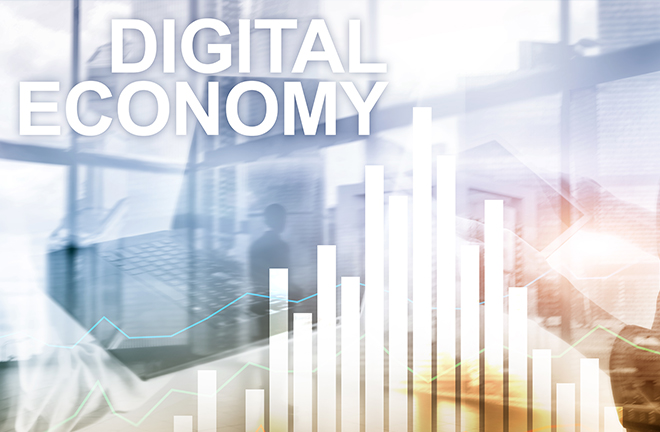Integrated development of digital and real economies

Digital economy Photo: Funtap/TUCHONG
The digital economy is a new economic form with data as a key factor of production, digital technology as the core driving force, and modern information networks as its primary conduit. It comprises elements of both the real economy and the intangible economy. The real economy involves the input of means of production and labor to engage in material production and create value. The intangible economy, associated with monetary and financial systems, does not directly produce material goods or create value by itself. Rather, it functions and grows by sharing the value generated in the material production process within the real economy, while also providing necessary non-production services for the real economy.
The integrated development of the digital economy and the real economy is represented by the development of the digital real economy itself (i.e. digital industrialization) on the one hand, and the empowerment and transformation of the traditional real economy by the digital economy (i.e. industrial digitalization) on the other. While digital technology can empower both the real economy and the intangible economy, greater emphasis should be placed on empowering the real economy to produce more material goods and accumulate more social wealth, thus laying a solid material foundation for China’s modernization. Regarding the intangible economy, digital technology facilitates the development of digital finance, which should complement the real economy while avoiding over-financialization.
The digital economy is transforming the inherent mechanisms of economic growth by enhancing efficiency across various dimensions, including factor transformation, factor empowerment, and factor interaction. Firstly, data itself drives economic growth due to its low costs associated with searching, replication, and transmission, as well as its non-exclusivity. Unlike traditional factors of production, data transcends growth constraints due to its near-infinite provision and extensive applicability across various domains.
Secondly, digital technology increases the marginal output of capital and labor. In terms of capital, the diffusion of digital technology can reshape production and management modes and improve the efficiency of capital accumulation. Digital finance can further reduce financing barriers and costs. In terms of labor, digital technology is conducive to the accumulation of new human capital and efficiency enhancement.
Lastly, the integration of digital technology with capital and labor improves the total factor productivity of society. The digital economy enables companies to achieve innovation-driven development through reduced marginal costs and economies of scale. Industry-wide, regional, and even global innovation networks are formed as digital platforms and networked division of labor lower the cost of information transmission and sharing.
The main approach to the integrated development of the digital economy and the real economy can be understood at the company, industry, and socio-economic levels. First, companies’ digitalization strategies involve overhauling various aspects of companies, including resources, innovation capabilities, business models and processes, products, services, and business ecosystems through learning, innovation, integration, collaboration, and other mechanisms. The digitalization of companies is centered on improving business performance and governance, facilitating technological innovation, and attracting talent through digital transformation, thereby eliciting positive responses from investors. This ultimately translates into a significant increase in valuation.
Second, the key to digital industrialization lies in accelerating the development of emerging digital industries such as artificial intelligence, big data, and cloud computing. Digital industrialization is the process wherein digital value chains are formed. Data equipment manufacturing, data services, data products, data applications, and other new digital industries are derived from the components of digital value chains such as data generation, data collection, data storage, and data analysis.
The transformation and upgrading of traditional industries, empowered by digital technology, consists of three aspects: the digital transformation of companies, the digital transformation of industry parks and industry clusters, and the development of the service ecosystem underpinned by transformation. The first two aspects entail “hard power” such as product research and development, process technology, and marketing. The third aspect entails “soft power” such as human resource development, organizational innovation, and the formation of the industrial ecosystem.
Third, the digitalization of social production is primarily embodied in digital and intelligent means of production and instruments of labor, platform-based and ecological production organizations, diversified and personalized product features, and enhanced international division of labor. The digitalization of social life is concentrated in the workforce and their families. Workers earn income at new jobs created within the digital economy, which permits improvements in the quality of consumption and in turn enhances the quality of reproduction of the labor force.
Digitalizing the way both society and the economy function requires deeper integration of “efficient markets” with a “capable government.” “Efficient markets” are essential for allowing the digital economy to fully realize its potential and facilitate social production. A “capable government” serves to strengthen the connections between governance bodies, improve the institutions and rules of digital governance systems, and build financial support systems that are more congruent with the development of the digital economy.
Chen Yulu is the president of Nankai University.
Edited by WANG YOURAN
